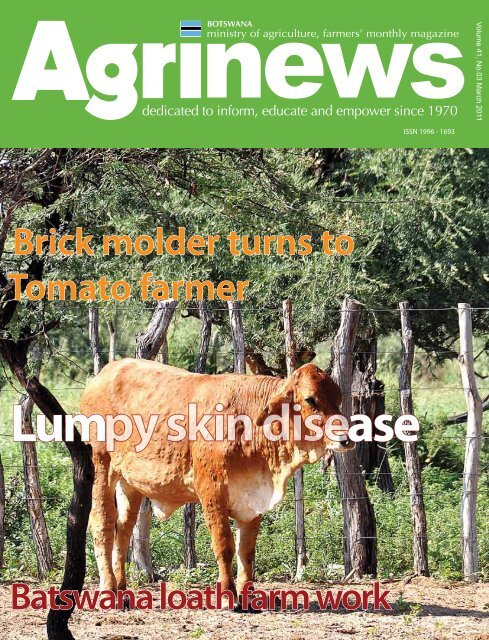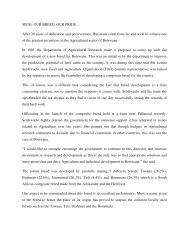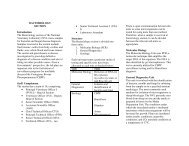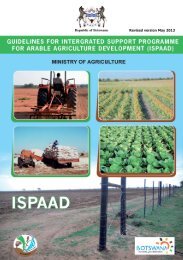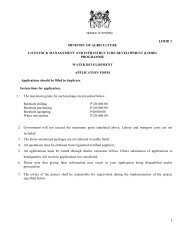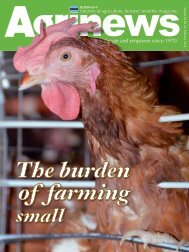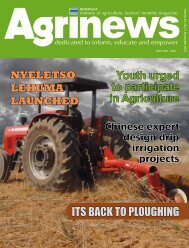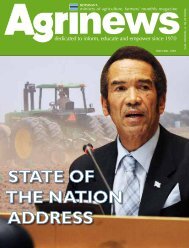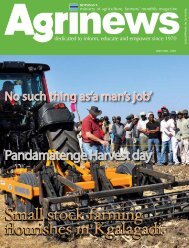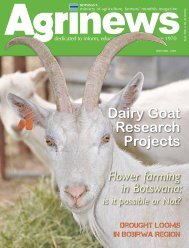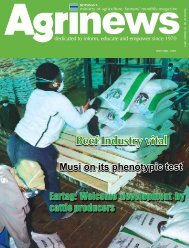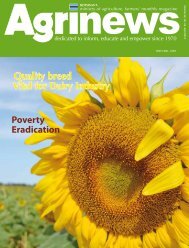Lum ase - Ministry of Agriculture
Lum ase - Ministry of Agriculture
Lum ase - Ministry of Agriculture
- No tags were found...
You also want an ePaper? Increase the reach of your titles
YUMPU automatically turns print PDFs into web optimized ePapers that Google loves.
A G R I N E W S February2 0 1 1Contents237EditorialFarmers employ traditional draught power12Brick molder turns to Tomato farmerPublic- Private Sector Partnership VitalStock theft rife in Semolale35611BMC export monopoly endsTwo senior citizens benefit from backyard gardensBobirwa on high alert <strong>of</strong> Foot and Mouth Dise<strong>ase</strong><strong>Lum</strong>py skin dise<strong>ase</strong>Pressrele<strong>ase</strong>MoA performanceimprovesTaukobong agricultural activistBatswana loath farm workVeterinary Lab receives equipmentTe<strong>ase</strong>rs791011121314151617614Managing Editor:Epena NgatangueEditor:Moreri MoesiReporters:France BegenselFelix MothategoTheresa MokgwathiDistributors:MokgarebeMotswakhumoEsther NkgwangHead <strong>of</strong> Graphics:Keabetswe MolebatsiDesigner:Ignacious KgaodiHead <strong>of</strong> Photography:Henry TotoPhotographers:Aggripah WillieGabatsoswe MogapiTshepiso KhethiweAddress your letters to: AGRINEWS, Letters to the Editor, P/Bag 003 Gaborone, Botswana. Tel: 3689135, Fax:3906769, Email: agrinews@gov.bw. MoA website: www.moa.gov.bw
editor’s noteVISIONFOUNDATIONPILLARSProverbs 14;23“In all labour there is pr<strong>of</strong>it,but idle chatter leads only to poverty.”MISSIONVALUES1. BOTHOWe treat our customers ina respectable and caring manner.2. TEAM WORK.3. CUSTOMER FOCUSEDOur customers are the focus<strong>of</strong> everything we do by beingcourteous, caring, compassionate,tolerant and empathetic.4. INNOVATIVEWe commit to employ new ideasand being proactive in order tomatch the requirements <strong>of</strong> thefuture.5. INTEGRITYWe foster a culture <strong>of</strong> transparency,accountability and dependability.The above verse is complimented by an assortment <strong>of</strong> proverbs such as ‘an earlybird catches the biggest worm.’ For fear <strong>of</strong> being caught in politics <strong>of</strong> religions,the verse is better read as it is. Its intepretation carefully left to the angels <strong>of</strong> theAlmighty.Is the verse revelant to the agricultural sector? Yes!!! The agriculture sector is litteredwith a lot <strong>of</strong> opportunities that needs to be harnessed and turned into a gold mine.It is a task that can be achieved through hard work. The agricultural sector hasproduced a lot <strong>of</strong> rich people. Many make millions through this sector.For example, if one planted 100 000 sweet reeds, and sells each one at one pulathat translates into P100 000.This picture shows how easily money can be made in the agricultural sector. Butit does not mean such money comes easy. It requires a lot <strong>of</strong> hard work. Workinghard includes manning the fields through out the ploughing season until harvest time.It also entails ensuring that pests are eliminated as they can affect the quality <strong>of</strong>a farmer’s produce. It starts at the time <strong>of</strong> ploughing until the product reaches aconsumer. It is a 24 hour work. The product has to be delivered to the market ontime and at the right time. E.g. Failure to deliver green mealies at the right time cannegatively affect a farmer’s balance sheet.Therefore quality assurance through out the production chain is very important.Quality assurance can come in the form <strong>of</strong> taking care <strong>of</strong> one’s fields by amongstothers waking up very early in the morning.In today’s world where consumers are spoiled for choice, they would not buy anythingthey consider to be <strong>of</strong> less quality.Just like in the shares industry, where the value <strong>of</strong> shares can be affected by theturbulance in the world market. It happened during the recent economic recession.Similarly, taking care <strong>of</strong> the field can be negatively affected by other external factorssuch as adverse weather conditions. But such events cannot be used as an excuseby farmers to neglect their fields.As human beings we do not have any control over the weather. Equally so there arethose things that we have control over such as taking care <strong>of</strong> a field.Just like a person who works in an <strong>of</strong>fice and has made going to the <strong>of</strong>fice on timehis/her tradition, we also should at our farms/fields make that a tradition.If we start work in our fields at the right times and manage our livestock accordingly,then we can restore the esteem <strong>of</strong> the agricultural sector.The undesputed fact is that the sector is at the centre stage <strong>of</strong> life. Whether thereis recession or not people would always want to have something to eat. This is theonly sector through which one can easily break even. <strong>Agriculture</strong> has a lot <strong>of</strong> pr<strong>of</strong>itprovided we labour and Proverbs 14; 23 says those’ who ‘idle will perish in povertyand hunger.1
Farmers employ traditionaldraught powerArticle: Felix MothategoPhoto: Aggripah WillieShortage <strong>of</strong> tractors in the aridKgalagadi North has had an inspiringeffect on some dry land farmers.Against all odds they have incre<strong>ase</strong>d theirself respect, and confidence in themselves.These are the likes <strong>of</strong> Khwae Reapereng <strong>of</strong>Tshane village, whom after realising thattractors were few, used his 2.7 litres fourwheel drive Toyota Hilux to pull the plough.This man is also determined to securehis dream <strong>of</strong> commercial farming, andwith this end in view, he joined theonly cluster <strong>of</strong> farmers in Tshane. Theiridea is to fence fields into one big field,and plough as a team. Through theIntegrated Support Programme for Arable<strong>Agriculture</strong> Development (ISPAAD) fencingcomponent; government would provide them with fencingmaterials.Some farmers decided to be patient and it worked for them.Hiri Hiri queued for a while before the tractor showed up.He decided to plough only five hectares which is paid for byISPAAD due to time constraints, and that he does not havemoney.In Kang, Dorah Moabia used donkeys to plough. She saidwaiting for a tractor was not an option because the stakes werehigh. “I could have lost a lot <strong>of</strong> moisture in the soil throughevaporation.”An expert in farm machinery at the <strong>Ministry</strong> <strong>of</strong> <strong>Agriculture</strong>,Kabomo Segokgo Nelson said it is not advisable to use lightvehicles to pull the plough. He said a 2.7 liters engine ToyotaHilux has a pulling power <strong>of</strong> 18kilowatts ascompared to 35 kilowatts <strong>of</strong> a tractor.He said using <strong>of</strong> a single furrow plough andthe sandy soil <strong>of</strong> Kgalagadi are two reasonsthat could have allowed the farmer to use alight vehicle to plough. He said a lot <strong>of</strong> fuelis used as only lower gears are used, andthat one could damage the vehicle. “Thisis a clear misuse.”Tshane b<strong>ase</strong>d agricultural demonstrator,Botlhe G<strong>ase</strong>itsewe said there is onegovernment tractor in Hukuntsi, Lekgwabe,Lehututu, and two in Kang. She said whenthe ploughing season began the only tractorthat people queued for broke down, leavingKhwae Reaperengfarmers stranded.As a consequence out <strong>of</strong> 40 farmers whocollected seeds from her <strong>of</strong>fice, only 17managed to plough, six used tractors, andthe rest used donkeys. Botlhe advisedfarmers to use donkeys because the queuefor tractors was long. However, since theyouth are not interested in farming, elderlyfarmers could not plough using donkeysby themselves.District Agricultural Officer (DAO) inHukuntsi Sebero Kapeko confirmedthat shortage <strong>of</strong> tractors, and farmingimplements is a stern reality glaringfrightfully upon them.He said it has torn farmers to pieces by itsmerciless fangs, and that ploughing seasonbegun under a great shadow. Kapeko said only 162 hectareswas ploughed by 400 farmers. The number <strong>of</strong> farmers wentdown as compared to 500 last year. About 493 were givenseeds and fertilizers but only seven made use <strong>of</strong> the fertilizer.He said three hectares <strong>of</strong> sorghum, 43 hectares <strong>of</strong> beans, 21hectares <strong>of</strong> melons, and 43 hectares <strong>of</strong> sweet reed were plantedin the district. The DAO said crops such as melons, sorghum,beans, and lab lab do well in Kgalagadi but farmers prefer maize.He said Kgalagadi soil has a deficiency <strong>of</strong> phosphorus, andthat when this is applied food can be produced in this desert.However, striking as it is gratifying, farming here has been more<strong>of</strong> sunshine than a cloud, and more <strong>of</strong> calm than a storm. It hasbeen a cheerful farming because <strong>of</strong> ISPAAD.The country is striving to become self sufficient in food productionMarch 20112
Public- Private Sector Partnership VitalArticle: Epena NgatanguePhotos: Gabatsoswe MogapiContemporary leaders haverealised that governments cannotsolve challenges emanating fromdevelopment with a government-centricapproach. Collaborative endeavourbetween the government and theprivate sector creates a good platformfor sustainability <strong>of</strong> developmentprogrammes.Through jointly defined objectives,government and private sectorpartnership will go a long way increating a conducive environment fordevelopment. It is along this modelthat the forum <strong>of</strong> the AgriculturalSector Committee <strong>of</strong> the High LevelConsultative Council (HLCC) operates.The forum is meant to accord theprivate sector an opportunity tocontribute in the agricultural policyformulation and implementation forthe development <strong>of</strong> the sector. Theforum brings together key players inthe agricultural sector to map the wayforward for the sector.In a recent meeting the Minister <strong>of</strong><strong>Agriculture</strong> Mr Christiaan De Graaffconvened he encouraged members <strong>of</strong>the forum to actively participate in thedeliberations and assist the ministry inmapping the way forward for advancingthe improvement <strong>of</strong> the sector.He told the gathering that theagriculture sector has shown a substantialincre<strong>ase</strong> <strong>of</strong> 40.3 percent, which he said“leaves us as role players in the sectorwith a big challenge to strive harder inorder to achieve more in agriculturalproduction.”Minister De Graaff urged them to reflecton the sector’s major achievements andchallenges <strong>of</strong> the past year and forgeahead.He cited the closure <strong>of</strong> the BotswanaMeat Commission (BMC), outbreaks <strong>of</strong>Foot and Mouth Dise<strong>ase</strong> (FMD) and<strong>Lum</strong>py skin as some <strong>of</strong> the challengesfaced by the ministry.On a positive note, the Minister toldthe forum that the Mmadinare/Bobirwaarea (Zone 7) has been declared FMDfree without vaccination by the WorldOrganization for Animal Health. The<strong>Ministry</strong> is currently negotiating withtrading partners, notably the EuropeanUnion and South Africa to start acceptingbeef originating from Zone 7.De Graaff further announced thatthere has been no c<strong>ase</strong> <strong>of</strong> FMD inNgamiland since November 2009.On arable farming, the Minister saidsince inception <strong>of</strong> ISPAAD, farmers’participation has incre<strong>ase</strong>d by 11percent over two seasons in 2008/2009and 2009/2010, whilst the area plantedhas incre<strong>ase</strong>d by almost three folds.The introduction <strong>of</strong> HorticultureDevelopment Programme under ISPAADis another milestone in the diversification<strong>of</strong> the agricultural production b<strong>ase</strong>. “Thiswould create employment opportunities,improve the nutritional status <strong>of</strong> thenation and alleviate poverty.”The forum further heard that the reviewMinister De Graaf and Chimbombi<strong>of</strong> the National Policy on AgriculturalDevelopment has started and progressingwell and the ministry will embark onan intensive stakeholder consultationprocess to ensure that all players have aninput in the development <strong>of</strong> the sector’spolicy and associated strategies.All in all this is to say that it wouldtake the whole team, stakeholders aliketo take the agricultural sector to higherlevels.5March 2011
Stock theftrife inSemolaleArticle: Theresa MokgwathiPhotos: Tshepiso KhethiweAs you drive around and into thesmall village <strong>of</strong> Semolale, 48kilometers North <strong>of</strong> Bobonong,one’s eye hardly meets the sight <strong>of</strong> anylivestock. Stock theft in Semolale is onthe rise and the perpetrators are not onlythe locals but also from neighbouringZimbabwe. “Our statistics showthat a number <strong>of</strong> reported c<strong>ase</strong>s aredone by Zimbabweans but we alsohave reported c<strong>ase</strong>s <strong>of</strong> locals,” saidGaodirele Motlhagodi.Po l i c e S t a t i o n C o m m a n d e r,Motlhagodi <strong>of</strong> Semolale indicatedthat in 2010 there were a number <strong>of</strong>stock theft c<strong>ase</strong>s reported into their<strong>of</strong>fice. Most <strong>of</strong> the c<strong>ase</strong>s revolvedaround cattle’s from Botswana beingcrossed illegally to Zimbabwe byZimbabweans. He said these incidentsusually happen during the night andin the early mornings.In the first quarter <strong>of</strong> the year 2010eighty-seven (87) stock theft c<strong>ase</strong>swere recorded, being 36 donkeys,45 cattle and six small stocks. In thesecond quarter, 74 stock theft c<strong>ase</strong>swere reported, with 37 being smallstock, 36 cattle and one donkey, in thethird quarter they received a total <strong>of</strong> 56c<strong>ase</strong>s, with 38 donkeys, 18 cows andMotlhagodi said people do not lookafter their livestock; a thing he saidexacerbated stock-theft. He said theBobirwa area has a lot <strong>of</strong> livestockand a good number <strong>of</strong> those are straycattle, noting that stray livestock areeasy target for thieves. Such livestockin most c<strong>ase</strong>s find their way acrossthe Shashe River, which separatesBotswana and Zimbabwe.The Station Commander furthersaid together with members <strong>of</strong> theBotswana Defence Force (BDF) theyfrequently patrol the boarder ina bit to curb cross-border stocktheft. Motlhagodi also hailed thegood working relationship with theirZimbabwean counterparts on issues<strong>of</strong> cross border stock theft.He complained about farmerswho take time to report their missinglivestock as well as those who fail tocollect them from the police.Motlhagodi emphasised theimportance <strong>of</strong> branding, urging farmersto brand their calves immediatelywhen they are mature enough. Heappealed to farmers to look after theirlivestock to curb stock theft in theirvillage.ABOVE:Gaodirele MotlhagodiLEFT:Branding helps curb stocktheftMarch 2011 6
BMC export monopoly endsArticle: Goabaone Abby MolapisiPhotos: Gabotsoswe MogapiBotswana Meat Commission (BMC)is likely to face stiff competitiononce its export monopoly isrescinded.Mr Philip Wright, a member <strong>of</strong> theHainaveld Farmers Association saidthe amendment <strong>of</strong> Section 21 <strong>of</strong> theBMC Act, would allow farmers to targetneglected markets.The BMC, he says failed to market beefproperly as it only concentrated on theEuropean Union (EU) market.Minister <strong>of</strong> <strong>Agriculture</strong>, Mr ChristiaanDe Graaff is to table before Parliamentan amendment bill <strong>of</strong> the Act this year.Wright argues that BMC failed topenetrate other markets although onlya few tonnes <strong>of</strong> beef go to EU.Farmers complain that EU’s toughconditions make it difficult for beefproducers to supply them.“They say they want lean meat. Whatis lean meat?” he asked rhetorically.For his part, Dr David Falepau, BMCChief Executive Officer (CEO) says theabbatoir is not worried as it is the onlylegitimate export abattoir in Botswana.He says farmers will still have to useits facilities to slaughter for export, as itwill take a while for farmers to set up astandardized abattoir similar to theirs(BMC).BMC is also sure <strong>of</strong> supply <strong>of</strong> animalsbecause exportation <strong>of</strong> live animals willnot be permitted even under the newdispensation.Exportation <strong>of</strong> live animals, BMCargues, will be tantamount toexportation <strong>of</strong> jobs.Permanent Secretary (PS), <strong>Ministry</strong><strong>of</strong> <strong>Agriculture</strong> (MoA), Dr MicusChimbombi said BMC will have t<strong>of</strong>ind a new growth opportunity. Hesaid amendment <strong>of</strong> the Act will allowanyone to export processed meatproducts.This according to the PS will create anenvironment conducive for the growth<strong>of</strong> the agricultural sector.“The intention is not to kill BMC buton the other hand we do not wantthe abattoir to stifle the growth <strong>of</strong> thesector.”Chimbombi said BMC is at anadvantage because it is an alreadyestablished exporting entity.According to the current BMC Act, noperson other than the Commission shallexport cattle or edible products fromBotswana, unless in possession <strong>of</strong> apermit in writing to do so issuedby the Minister.The Act also stipulatesthat no such permit shallbe issued without theconcurrence <strong>of</strong> theCommission or unless the Ministerdeclares by order published in theGazette, that it is clearly in the publicinterest to issue such permit without theconcurrence <strong>of</strong> the commission.Minister De Graaff had earlier toldthe BMC Board to be prepared for theproposed changes and to take advantage<strong>of</strong> the changes to improve performance.He said they should work as ateam,and that he wasdisappointedwith the factthat beforethere wasno teamw o r kwithin theboard.BMC products face competitionDr Falepau, the new CEO7March 2011 2011
Ramotswa123451The beneficiary Ms Porogwane (left), South East District Council chairperson, Mrs Anne Joubert(c) and MoA Senior Manager, Mrs Oemetse Nkoane during the groundbreaking2345Employees preparing seed bedsMs Rebecca Munisola <strong>of</strong> <strong>Ministry</strong> <strong>Agriculture</strong> helping Ms Porogwane plant the seedlingsEmployees bought Ms Porogwane some food itemsMs Porogwane’s garden complete with a shade netMarch 2011 8
Morwa123123Masisi and PSP Mr Eric Molale during the backyard garden launch in MorwaMembers <strong>of</strong> the community helping out in Morwa to prepare a plotMorokane planting seedlings in her new backyard garden4 Office <strong>of</strong> the President and agriculture staff setting up a backyard garden plot lot 5Two senior citizens benefit from backyard gardensStory: France BegenselPhotos: Mogapi Gabotsoswe and Tshepiso Kethiwe4Planting seedlings5Public <strong>of</strong>ficers put smiles on the faces<strong>of</strong> 84 year-old, Ms MaditlhongPorogwane <strong>of</strong> Ramotswa and 74year-old Tebogo Mmapetori Morokane<strong>of</strong> Morwa village.Each <strong>of</strong> the two received a backyardgarden during the public <strong>of</strong>ficers’community service day in February.The two received their backyardgardens complete with amongst othersshade nets, seedlings and 5000 litreswater container to start production.<strong>Ministry</strong> <strong>of</strong> <strong>Agriculture</strong> led SouthEast District employees to set up thegarden while the other one led by theMinister <strong>of</strong> Presidential Affairs andPublic Administration, Mr MokgweetsiMasisi was involved in a similar projectin Morwa village.About 200 backyard gardens are to bebuilt in each district through the povertyeradication programme.Touched by the dilapidated door <strong>of</strong>Porogwane’s two-roomed house, theemployees went an extra mile andcontributed some funds on the spot tobuy and fit the house with a new door.9March 2011
Article: Theresa MokgwathiPhotos: Tshepiso KhethiweMolebatsiBobirwa on high alert <strong>of</strong>Foot and Mouth Dise<strong>ase</strong>Yet another outbreak <strong>of</strong> Footand Mouth Dise<strong>ase</strong> (FMD) inn e i g h b o u r i n g Z i m b a b w eis making Babirwa nervous. Thecommunity is right to be nervous, asit faced the same predicament aboutfive years ago-when the dise<strong>ase</strong> spreadinto the country.Just when they thought things werereturning to normal, another outbreak<strong>of</strong> the dise<strong>ase</strong> was reported in Gwanda,Zimbabwe about 30 kilometres fromthe border with Botswana.The faces <strong>of</strong> Babirwa showdisappointment as they fear for theirlivestock. They know that if the dise<strong>ase</strong>spread into their area it will be declareda red zone.“I am here today to plead with you tojoin forces with the government againto help prevent the spread <strong>of</strong> FMD intothe country,” said Oreeditse Molebatsi,Assistant Minister <strong>of</strong> <strong>Agriculture</strong>.As a precautionary measure,residents should inter alia; ce<strong>ase</strong>from importing meat fromZimbabwe and stopemploying illegalimmigrants.Lasttime when Babirwa were told <strong>of</strong>the similar dise<strong>ase</strong> out break nearPlumtree, residents cooperated wellwith the government.Botswana also recognised thegood working relationship betweenB o t s w a n a a n d Z i m b a b w e a nveterinarians whenever there is anoutbreak.Molebatsi commended Zimbabwefor always alerting Botswana on timewhen there is an outbreak <strong>of</strong> FMDin that country. He said that helpsBotswana to take precautions wellin time.For his part, Kgosi MerwaMalema <strong>of</strong> Bobonong commendedthe government for sensitizing themabout the outbreak in Zimbabwe.“Thank you for coming to let us knowwell in time so that we can prepare forthis situation.”He asked for an electric fence to beerected along the Shashe River to actas a border between Botswana andZimbabwe. The fence, he said will alsoprevent stocktheft and the spread <strong>of</strong>FMD from Zimbabwe.The Minister was also givenan update on the development <strong>of</strong>Bobonong by Bathoeng Malemeyane,chairperson <strong>of</strong> the Village DevelopmentCommittee. Malemenyane said thatone <strong>of</strong> the committee’s commitmentsis to produce enough food for thecountry. He noted that the initiative isinfluenced by the fact that Bobononghas enough under ground water.High alert to ensure FMD does not spreadinto Botswana. file photoMarch 2011 10
What is <strong>Lum</strong>py skin dise<strong>ase</strong>?<strong>Lum</strong>py skin dise<strong>ase</strong> (LSD) is an infectious dise<strong>ase</strong> <strong>of</strong> cattlecaused by a virus. The dise<strong>ase</strong> commonly known as “Nkokomanein Setswana” is characterized by the eruption <strong>of</strong> nodules on theskin and other parts <strong>of</strong> the body.How is <strong>Lum</strong>py skin dise<strong>ase</strong> transmitted?Biting insects or flies (e.g. mosquitoes, stomoxysis) areconsidered to be the main vectors in the transmission <strong>of</strong> LSD. Thedise<strong>ase</strong> is therefore more commonly seen during wet summer andautumn months; the period during which the biting fly densityis highest.What are the clinical signs <strong>of</strong> <strong>Lum</strong>py skin dise<strong>ase</strong>?• Incubation period (time from infection to appearance<strong>of</strong> clinical signs <strong>of</strong> dise<strong>ase</strong>) is 4 – 14 days. Early signs are loss <strong>of</strong>appetite, salivation, discharges from eyes and nose• Nodule: Skin nodules appear on the skin and arerandomly distributed. The nodules range in diameter from5 – 50 mm; they are well-circumscribed, firm and round. In acut section, the nodule appears creamy-gray or yellow mass <strong>of</strong>tissue. Nodules may also occur on the muzzle and within themembranes lining the nasal and mouth cavities. The skin noduleseither resolve rapidly, become indurated (in which c<strong>ase</strong> theymay persist as hard lumps or ‘sitfasts’ for 12 months or longer)or become sequestrated to leave deep ulcers.• Swollen legs (due to subcutaneous edema) resultingin lamenessWhat is the treatment for lumpy skin dise<strong>ase</strong>?There is no treatment for LSD. Secondary infection by bacteriacan be controlled by administration <strong>of</strong> broad-spectrum antibiotics(e.g. tetracycline) and sulfa drugs (sulphonamides). When yousee your animals showing the clinical signs described above,immediately contact your veterinary agent so that you can beassisted. Good nursing care should always be exercised for thesick animals.How is <strong>Lum</strong>py skin dise<strong>ase</strong> controlled?Vaccination is the method <strong>of</strong> choice for the control <strong>of</strong> LSD inyour cattle post. Both live (attenuated) and dead (inactivated) LSDvaccines are commercially available. The live vaccine confers alife-long immunity after a single injection and is therefore themost preferred. Booster vaccination will be required should youopt to use the inactivated LSD vaccine. Contact your veterinarydoctor or veterinary <strong>of</strong>fice closest to your cattle post for moreadvice on control <strong>of</strong> LSDWhat are the effects <strong>of</strong> <strong>Lum</strong>py skin dise<strong>ase</strong>?Affected animals recover and mortality is usually low. Thegreatest loss is due to decre<strong>ase</strong>d milk yield, loss <strong>of</strong> condition(emaciation), and rejection or reduced value <strong>of</strong> hide.<strong>Lum</strong>py skin causes nodules on the animal11March 2011
Pressrele<strong>ase</strong>sREINSTATEMENT OF ZONE 7 AS FMD FREE ZONE WITHOUT VACCINATIONThe Department <strong>of</strong> Veterinary Services informsthe general public and the farming communitythat the World Organization for Animal Health(OIE) reinstated Zone 7, Selibe-Phikwe districtas an FMD free zone without vaccination. Thisrecognition comes after a successful eradication<strong>of</strong> the 2006 Foot and Mouth dise<strong>ase</strong> outbreak inthe zone.The zone has only regained the FMD free statusbut not the export status to the European Union(EU). As the zone is not an EU eligible export zone,movement <strong>of</strong> cloven ho<strong>of</strong>ed animals and clovenho<strong>of</strong>ed derived fresh products is not allowed out<strong>of</strong> the zone until the zone has regained the EUexport status. Therefore the current movementcontrols remain in place until negotiations withtrading partners have been concluded.The Department has opened negotiations withtrading partners to facilitate trade <strong>of</strong> livestock andlivestock products.DECLARATION OF ZONE 4a AS EU EXPORT ZONEThe Department <strong>of</strong> Veterinary Servicesinforms the farming community and thegeneral public that Zone 4a will be anEuropean Union(EU) export zone with effect from10 th March 2011. Zone 4a is an area betweenMokobaxane and Makalamabedi veterinarydise<strong>ase</strong> control fences.This dispensation follows the recognition <strong>of</strong>zone 4a in May 2010 by the World Organisation<strong>of</strong> Animal Health (OIE), as an FMD free withoutvaccination zone and the successful conclusion <strong>of</strong>trade negotiations with the EU and other tradingpartners.A 10km-wide intensive surveillance bufferzone in 4a, along the boundary with the foot andmouth dise<strong>ase</strong> vaccination zone (Ngamiland andNata districts) and the wildlife management areaswill not be eligible for the EU market. This is part<strong>of</strong> the early warning system meant to detect thedise<strong>ase</strong> early should it occur.A detailed movement protocol for clovenho<strong>of</strong>ed animals and their fresh products will becommunicated later.Notwithstanding these positive developments,farmers and members <strong>of</strong> the public are urgedto continue to be vigilant and take necessaryprecautionary measures to avoid the reintroduction<strong>of</strong> the dise<strong>ase</strong> in this zone.The <strong>Ministry</strong> takes this time to thank all farmersand the general public for cooperation with<strong>of</strong>ficials <strong>of</strong> the Department <strong>of</strong> Veterinary Services,over the years when we worked tirelessly to attainthis status.March 2011 12
MoAperformanceimprovesArticle: Violet MompatiPhoto: Mogapi GabatsoswePerformance <strong>of</strong> the <strong>Ministry</strong> <strong>of</strong><strong>Agriculture</strong> (MoA) has greatlyimproved.Minister <strong>of</strong> <strong>Agriculture</strong>, ChristiaanDe Graaff said that when addressingDistrict Coordinators in Gaborone inFebruary.They met to map the way forwardto improve performance and servicedelivery in 2011.The Minister said performanceimproved from 56% to 85% thendropped to 71% and remains atposition six in all Ministries.Coordnators were urged to work as ateam, and deliver quality service.He urged them to take assignmentsseriously and meet deadlines. Healso reminded them to build trust byhonoring promises to their customers.De Graaff said inclusion <strong>of</strong>Horticulture in the Integrated SupportProgramme for Arable <strong>Agriculture</strong>Development (ISPAAD) couldimprove the livelihood <strong>of</strong> people.He requested that extra effort beundertaken to produce more food,and reduce imports expenses.Commonly imported agriculturalproducts include; Cabbage, Kale,Rape, Spinach, tomato, potato, onion,beetroot, butternut, carrot, greenpepper, sweet potato, watermelon,orange, green mealies, cucumber,lettuce and pumpkin.The import bill for vegetables isabout P200 million per annum.He said the land that is lying fallowMinister De Graaff andthe PS Dr MicusChimbombi addressing district coordinatorshas to be put to good use, and itis MoA’s responsibility to identifyagricultural land, and avail it t<strong>of</strong>armers. The other responsibility isto advice farmers about maintenance,and promotion <strong>of</strong> valuable use <strong>of</strong> fields.De Graaff said ISPAAD has ple<strong>ase</strong>dfarmers, and that many have returnedto their fields.However, he voiced concernthat policies and programmes <strong>of</strong>government are not driven downto extension staff. This is apparentfrom ignorance and disregard <strong>of</strong>government policies by staff.Land available for farming inBotswana is about 325 000 hectares.Mrs Makgethe, Chobe Coordinator contributing during the meeting13March 2011
By Theresa MokgwathiDid you know?Jatropha is believed to have been spread by Portuguese seafarers from its centre <strong>of</strong> origin in Central America and Mexico via Cape Verdeand Guinea Bissau to other countries in Africa and Asia.Did you know?Malaysia is the world largest exporter <strong>of</strong> palm oil.Did you know?The agricultural sector has led a vigorous recovery <strong>of</strong> the Chilean economy from its 1982-1983 crisis.Did you know?Chilean agriculture benefits greatly from the country’s Mediterranean climateDid you know?Most if not all employees in the <strong>Ministry</strong> <strong>of</strong> <strong>Agriculture</strong> are later influenced to have agricultural business projectDid you know?Brazilians love red meat as much as Batswana do.Did you know?Infrastructure quality and quantity are <strong>of</strong>ten identified as key determinants <strong>of</strong> farm investment and <strong>of</strong> non-farm business investmentsDid you know?Chinese staple food is rice. Hide and speakDid you know?Water logging is an <strong>of</strong>ten overlooked problem in crop productionDid you know?The widely used animals for guarding livestock are dogsDid you know?May ford carrot seed variety can withstand heat and resist leaf dise<strong>ase</strong>s in the summer-rainfall regions <strong>of</strong> the countryDid you know?Beef measles is caused by a parasite- Taenia saginata, a tape worm that lives in the intestine <strong>of</strong> humansDid you know?Livestock management practices and predator management methods can effectively reduce livestock lossesWhich is the oldest animal in the world? Zebra, it still only comes in Black and WhiteWhat is the opposite <strong>of</strong> Dominoes?Domi doesn’t knowWhat is the richest kind <strong>of</strong> air? BillionaireWhy do birds fly south in winter? It’s too far to walkWhat goes up but never comes down? Your ageWhich is correct? “Egg yolk is white or Egg yolks are white” Neither, egg yolks are yellowWhich bird is always out <strong>of</strong> breath? A puffinWhat is a Parrot’s favorite game?17March 2011 2011


